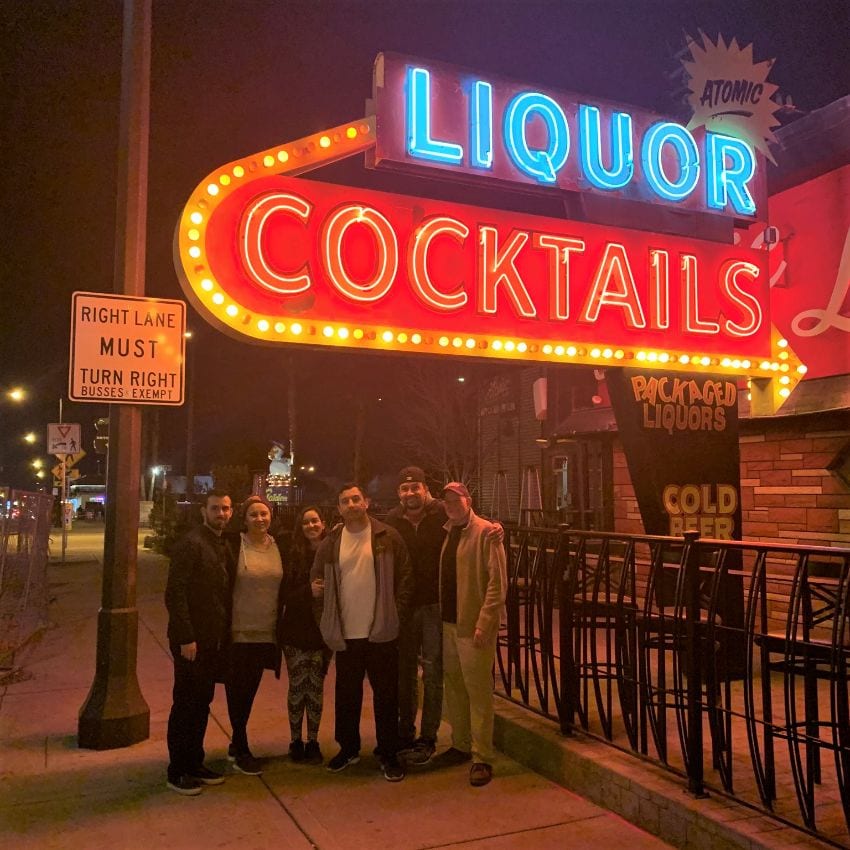Gary and Margie, a spirited couple from Florida, signed up for a weekend walking tour of Fremont Street and they especially wanted to see the neon lights of Downtown.
What time does it get dark in Las Vegas?
We started the tour later, at 4:00 pm, just about an hour before sunset. In fact, visitors often ask “what time does it get dark in Las Vegas?” because many have come to see for themselves the great neon signs and the electric architecture that have propelled the city into the public imagination. As usual, we met up with our Florida couple on the steps of the Mob Museum, and they were happy to know that on this January day, the sun would set at 4:48 pm, triggering the switch of Downtown to its nighttime neon glory. As a matter of fact, that time of twilight is sometimes called The Magic Hour, that moment of advancing darkness when the city’s neon signs are timed to flicker on.
Like most of our tour guests, our Florida visitors were staying on the Strip, and they ventured Downtown to get a sense of the history of this place, not just Las Vegas, but of the whole metropolitan Valley. Standing on the steps of the Mob Museum in the long shadows of the Downtown Grand Hotel and Casino, I pointed out that the city’s historical chapters are brilliantly referenced at the corner of Stewart Avenue and Third: the original Stewart Ranch, the Vegas Rancho, the land upon which the City was founded; the Federal Courthouse built as a grand citadel of the Hoover Dam era; and the Mob Museum, itself, telling the story of how organized crime and gambling fashioned much of the city’s history during the golden era of the 1950s and 1960s.
As dusk descended, we stepped into the lobby of the Mob Museum to check out its classic 1930s interior, and then we headed to Fremont Street, ablaze in neon, electric lights, and electronic razzle-dazzle. The Fremont Street Experience, said to be the largest video screen in the world, was built in 1995 in an effort to reinvent old Downtown Las Vegas with a world class attraction that would be a destination in and of itself. It worked: the canopy saved Downtown, and as architecture and spectacle, it strengthened the paradigm of Las Vegas at its best, as a city built around innovative light architecture.
Now, standing at Third Street in the historic casino district that began in 1931 with legalized gambling, our Florida visitors happily bathed in the sparkle of the scintillating yellow bulbs of the 4 Queens Casino Hotel and the red neon luster of the Fremont Hotel and Casino. We headed up the plaza to the corner of Casino Center, aka Glitter Gulch, a site that features the most historic concentration of historic neon on the planet. It is pure spectacle. A site of pilgrimage. It is the place that people come to Las Vegas to experience.
Our Floridians were somewhat knowledgeable about the 4 famous casinos at the corner: The historic Golden Nugget with its classic 1980’s white-and-gold Beverly Hills style façade; the 1950s Fremont Hotel and Casino, a midcentury modern masterpiece; the 1960s 4 Queens Casino Hotel with a Barbery Coast elegance styled by a famed corner bullnose sign; and the legendary Binion’s Horseshoe of 1950, a building ensconced in a magnificent electric sign embellished with 8 miles of turquoise neon. All around, the street was performing: the electronic canopy, the fabulous neon signs, zip lining enthusiasts, flare bartenders, performers on the curbside stages, dancing tourists, and a host of street buskers – from showgirls to Mickey Mouse.
We paid our respects to the famed Neon Cowboy Vegas Vic, the 1950s mascot of Fremont as a Frontier Town, and then we dropped by the new Circa Resort and Casino, a daringly vertical structure that’s become the electronic masthead of downtown. Its interior is new, slick, and styled visually like a glitzy-wired video game, but with a touch of mid-mod flare; and we found our way to Vegas Vickie, the lovely neon sign companion to Vegas Vic, now located in the rotunda of the hotel. We trekked over to Main Street Station Casino Hotel, evoking a Victorian era Railroad Palace, built around an opulent collection of historic antiques from around the world: beautiful stained glass, ornate chandeliers, turn of the century architectural elements, impressive statues, and unique memorabilia, including a slab of the Berlin Wall as part of the urinal of the Men’s Restroom.
Heading back to Fremont Street, our Florida visitors posed for a photo at the abrupt new junction that incorporates the neon geometry of Circa’s Garage Mahal and the gambling tableau of the towering mural at the Plaza Hotel. Finally, we arrived at the corner of Fremont and Main, the place where the city was founded in 1905 as a railroad stop in the middle of the Mojave Desert. Now the site of Plaza Hotel and Casino, an enduring 1970s classic composition of design simplicity, showcasing an exuberant and dazzling porte cochere that hosts a famed restaurant, Oscar’s that featured prominently in the movie Casino. We turned to survey the dazzling historic corner, remade, hosting the oldest hotel and the newest hotel drawn into the embrace of the expansive video canopy, and our Florida visitors were pleased, indeed, to stand at a new urban monument to light architecture in Las Vegas.



